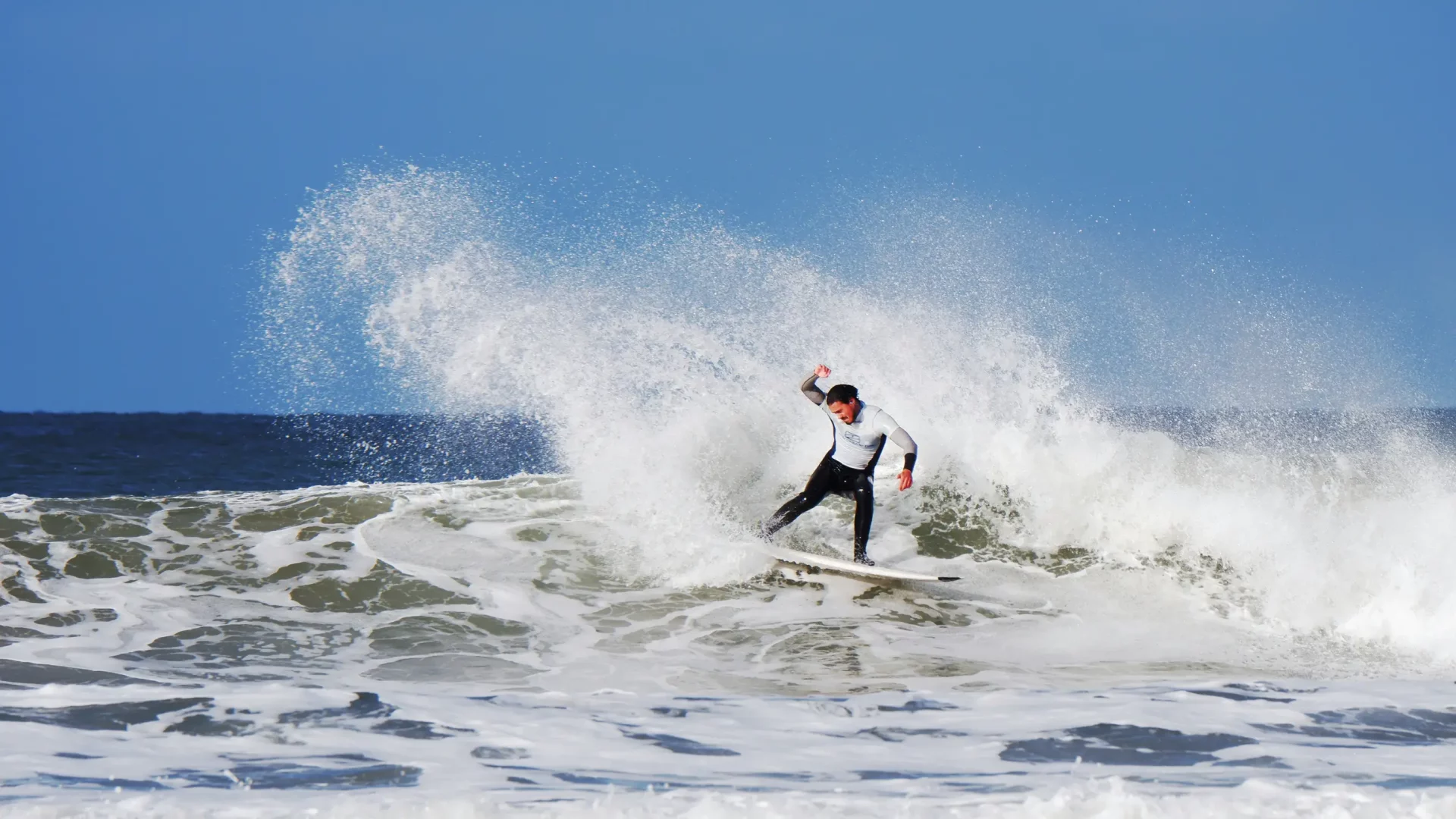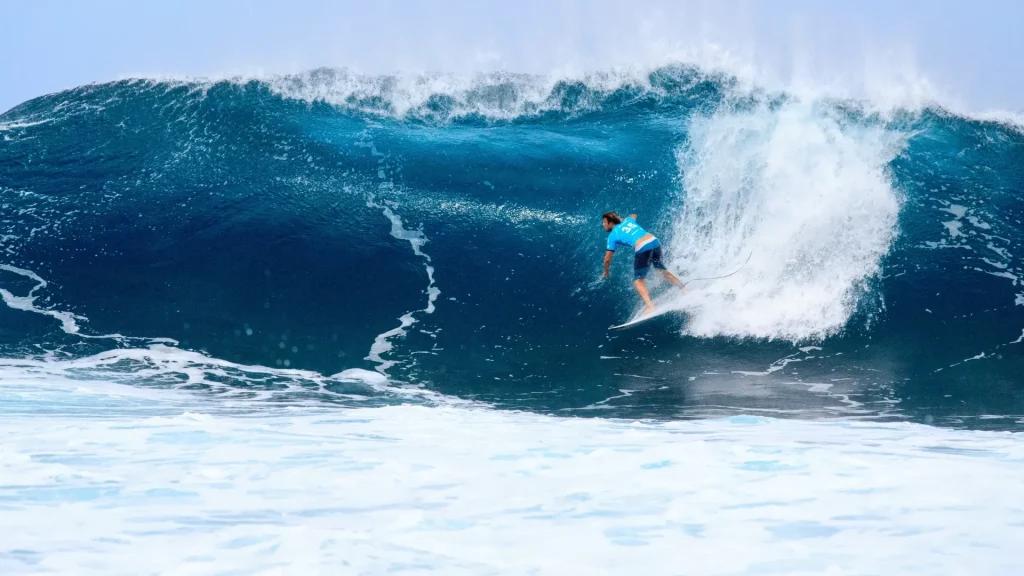What is a Surf Heat in Surfing?

Majority of surfers use surfing as an escape and a way to have fun while expressing themselves. Some surf competitively, which involves being part of a surf heat.
But do we know what a surf heat is?
Similar to other sports with competitive heats, surfing is no different. Let us explain!
What is a Surf Heat?
A surf heat is a competitive round in surfing where a specific number of surfers, typically 2 to 4, take turns riding waves within a designated time period.
Judges score each surfer's performance on their waves, and the surfers with the highest cumulative scores advance to the next round of competition.
For more surfing terms such as a surf heat view our Surfing Terms glossary.
What is a Surf Heat in Surfing?
A surf heat is a fundamental concept in the world of competitive surfing. It's essentially a battle in the water, where two or more surfers compete against each other to catch the best waves and earn points from judges.
Each heat typically lasts around 20 to 30 minutes, and surfers aim to ride the most impressive waves during this time.
In a heat, surfers are judged on their wave selection, manoeuvres, style, and the difficulty of the waves they ride.
These surf heats are the building blocks of surfing competitions, where surfers advance or get eliminated based on their performance in these individual matchups.
How Do Surf Competitions Work?
Surf competitions are exciting events that bring together the world's top surfers. They often take place over several days and can involve various rounds and heats.
These contests can be held at different locations worldwide, each with unique wave conditions.
Competitions are organised in a bracket-style format, where surfers are paired off against each other in heats. They earn points for their performance in each heat, and the best surfers advance to the next rounds.
Eventually, one surfer emerges as the champion, based on their consistent and outstanding performances throughout the competition.
Overall, surf competitions are a thrilling showcase of skill and talent, with surfers competing for the top spot and a chance to be crowned the champion of that event.

What are the Surf Heat Rules?
There are certain rules to follow in a surf heat to ensure a fair competition.
Firstly, surfers must respect a priority system, which determines who gets the right of way on a wave. This system prevents chaos in the water and makes sure surfers take turns to catch waves. So no Party Waves!
Additionally, there are rules about interference, where a surfer may lose points if they hinder their opponent's scoring potential.
Judges use a scoring system to evaluate each surfer's performance, considering factors like speed, power, and flow during their rides.
What is a Surfing Round?
A surfing round refers to a segment of a surf competition where surfers compete against each other in a series of surf heats.
The format of these rounds can vary depending on the competition and the number of surfers involved. In some cases, rounds are organised as elimination rounds, where surfers who perform the worst are eliminated from the competition, and others advance to the next round.
Higher-level rounds often feature top-performing surfers, leading to the finals where a champion is eventually crowned. Surfing rounds are an essential structure within a competition, helping to determine which surfers progress and who ultimately wins the event.
Surfing Priority Rules in Competition
During surf heats, surfing priority rules are in place to maintain order and fairness in the lineup. Priority determines which surfer has the right of way when catching a wave.
The surfer with the highest priority has the first opportunity to catch an incoming wave, and other surfers must yield and wait their turn.
Priority is typically established at the beginning of a heat or through specific actions during the heat, such as a surfer catching a wave.
These rules are essential in preventing wave hogging and ensuring that all surfers have an equal opportunity to showcase their skills during a heat. Violating priority rules can result in penalties, affecting a surfer's overall score.
What is Interference in a Surf Heat?
Interference in a surf heat occurs when one surfer hinders or obstructs their opponent's scoring potential.
This interference can result from actions like intentionally blocking the other surfer, catching a wave when not in priority, or making excessive contact during a ride.
When interference is called by judges or officials, the affected surfer may have their score for that ride reduced or even invalidated, impacting their chances in the heat.
Interference rules exist to ensure that surfers compete fairly and with respect for one another. It discourages unsportsmanlike conduct and ensures that each surfer has a fair opportunity to showcase their skills during the heat.
What is a Waiting Period?
A waiting period is a specific period of time during which a surf competition can take place. It typically encompasses several days or weeks and allows organisers to select the best days with optimal wave conditions for the event.
During the waiting period, competition officials closely monitor weather and swell forecasts, aiming to run the competition on days when the waves are ideal for the surfers to display their skills.
Waiting periods provide flexibility, ensuring that surfers compete in the best possible conditions, which can lead to more exciting and fair contests.
This approach is particularly important for professional competitions, such as the World Surf League, where top surfers aim to ride the best waves and spectators expect high-quality performances.
How Does Surf Heat Judging Work?
Surf heat judging is a crucial aspect of competitive surfing, where a panel of experienced judges evaluates each surfer's performance in real-time. These judges assess multiple factors to determine scores for each ride.
When a surfer catches a wave, judges look at elements like the quality of the wave, the surfer's wave selection, the difficulty of manoeuvres, style, flow, and how well they complete their chosen moves.
Judges typically use a scale of 1 to 10, with decimals allowed, to score each ride. The highest and lowest scores are often discarded, and the remaining scores are averaged to determine the surfer's total points for that ride.
How Are Surf Heats Scored?
In a heat, surfers aim to accumulate the highest total score possible. This total score is the sum of their best rides in that heat.
For example, if a surfer catches three waves during a heat, the judges will assign scores to each of those rides. The surfer's final score is the sum of the highest-scoring waves, usually the top two out of three.
The surfer with the highest total score at the end of the heat advances to the next round of the competition.
This scoring system ensures that surfers consistently perform at their best and showcase their skills in every surf heat. It's an exciting way to crown the top surfers and determine who moves forward in the competition.
How Long Do Surfing Competitions Last?
The duration of surfing competitions can vary depending on the specific event and conditions.
Some smaller contests may be completed in a single day, while larger, more prestigious competitions can last several days or even a week.
Professional events like the World Surf League (WSL) Championship Tour often have waiting periods, allowing organisers to pick the best days with optimal wave conditions for competition.
This flexibility ensures that surfers get to ride the best waves and spectators witness high-level performances.
How Is Big Wave Surfing Scored?
Big wave surfing is an adrenaline-pumping branch of the sport where surfers tackle massive waves that can tower over 20 feet or more. Scoring big wave surfing is different from regular competitions.
Here, surfers are typically judged on the size and difficulty of the waves they ride, as well as the courage and skill required to navigate these enormous swells.
While specific scoring systems can vary between big wave events, judges look for elements like wave height, drop-in, positioning, and how successfully the surfer rides the wave.
Safety and risk management also play a significant role, as big wave surfers often push the boundaries of what's possible in challenging and dangerous conditions.
The scoring is often based on a combination of these factors, emphasising the surfers' extraordinary feats in conquering colossal waves.
World Surf League (WSL)
What is the World Surf League and how does it work?
The World Surf League (WSL) is the premier organisation for professional surfing, overseeing competitive events around the world. It operates a Championship Tour where top surfers compete in surf heats, earn points, and aim to secure the title of World Surfing Champion based on their performances throughout the season.
The World Surf League (WSL) encompasses a set of crucial elements that determine the path to crowning a World Surfing Champion. The WSL Rule Book for 2023 serves as the guiding framework for all competitions, defining the rules and regulations that ensure fair play and competition integrity.
Within the WSL, surfers accumulate points in each event they compete in, governed by the WSL Points System per Event. These points contribute to their overall rankings, which are vital in securing a place in the prestigious Championship World Tour events.
To identify the next World Surfing Champion, a diligent process unfolds. Judges assess surfers' performances meticulously, analysing elements like wave selection, manoeuvres, style, flow, and difficulty.
The culmination of these factors influences scoring, a fundamental component in determining the Champion. The journey to the championship involves surfers vying for their place based on rankings and performances, allowing only the elite to partake in Championship World Tour events.
Ultimately, it's the consistent excellence and strategic prowess of the surfers that decide who rises to the pinnacle as the World Surfing Champion.
Summing It Up: What To Do Now
Now if you ever enter a surf competition you will be confident in understand what a surf heat is. Good luck if you have a upcoming competition! Make Sure You Know What Pitted Means!
If your interested in learning more about surfing discover our many guides that will inform you on your surfing journey. Don't forget to follow us on Facebook & Instagram to stay informed on our amazing surf shots and stories shared from surf creators around the world!
Frequently Asked Questions
How many surfers in a surf heat?
The number of surfers in a heat typically varies, but it's commonly 2 to 4 surfers competing in a single heat.
Why are surfers so chill?
Surfers are often perceived as "chill" due to their connection with the ocean and the laid-back culture associated with the sport. The relaxed atmosphere, love for nature, and the thrill of riding waves contribute to their "chill" demeanor.
How do surfers not get cold?
Surfers avoid getting cold in cold water by wearing wetsuits, which insulate their bodies and help retain heat. Wetsuits are made of neoprene material, which traps a thin layer of water against the skin and prevents it from flushing out, thus keeping surfers warm.
How do WSL heats work?
World Surf League (WSL) heats work by grouping surfers into competitive heats, where they take turns riding waves to showcase their skills. The judges score each wave, and the surfers with the highest cumulative scores advance to the next round.
What is an excellent wave score?
An excellent wave score in competitive surfing typically falls in the range of 8 to 10 points on a scale of 0 to 10. Excellent waves are characterized by their size, shape, and the surfer's performance on the wave.
Can you surf a 100-foot wave?
Surfing a 100-foot wave is exceptionally rare and extremely dangerous. Most surfers do not attempt waves of this size due to the immense risks involved. Only a select few big wave surfers with extensive experience and the right equipment would even consider attempting such massive waves.


